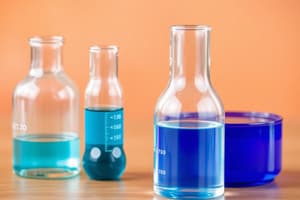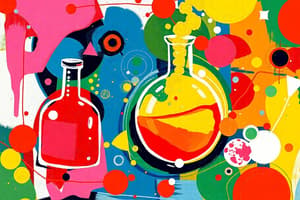Podcast
Questions and Answers
What is the definition of chemistry?
What is the definition of chemistry?
- The study of the universe and its celestial bodies
- The study of how different elements interact and form compounds
- The branch of science focused on the structure and behavior of atoms and molecules
- The study of the composition, properties, and interactions of matter, and the transformations it undergoes (correct)
Which of the following is NOT a characteristic of matter?
Which of the following is NOT a characteristic of matter?
- It occupies space
- It can be transformed into different forms
- It has mass
- It is always in a solid state (correct)
- It is composed of atoms
What is the main difference between matter and energy?
What is the main difference between matter and energy?
- Matter can exist in different states, but energy cannot
- Matter is composed of atoms and molecules, while energy is not
- Matter can be created or destroyed, while energy cannot
- Matter is tangible and can be touched, while energy is intangible and cannot be touched (correct)
- Matter is a form of energy
- Energy is a form of matter
What determines the state of matter?
What determines the state of matter?
Which of the following is an example of a chemical change?
Which of the following is an example of a chemical change?
Which of the following best describes the property of ductility?
Which of the following best describes the property of ductility?
What is the temperature at which a substance changes from a liquid to a gas called?
What is the temperature at which a substance changes from a liquid to a gas called?
Which of the following is NOT a chemical property of matter?
Which of the following is NOT a chemical property of matter?
What is the term used to describe the ability of a substance to conduct heat or electricity?
What is the term used to describe the ability of a substance to conduct heat or electricity?
Which of the following properties is associated with the arrangement of atoms in a substance?
Which of the following properties is associated with the arrangement of atoms in a substance?
A substance that can be broken down into simpler substances by chemical means is best described as a(n):
A substance that can be broken down into simpler substances by chemical means is best described as a(n):
What is the temperature at which a substance changes from a solid to a liquid called?
What is the temperature at which a substance changes from a solid to a liquid called?
Which of the following describes the tendency of a substance to react with acids?
Which of the following describes the tendency of a substance to react with acids?
Which of the following is an example of a heterogeneous mixture?
Which of the following is an example of a heterogeneous mixture?
Which of the following is NOT a characteristic of a chemical reaction?
Which of the following is NOT a characteristic of a chemical reaction?
Which of the following processes is NOT a food preservation technique?
Which of the following processes is NOT a food preservation technique?
Which of the following is an example of a reversible change in matter?
Which of the following is an example of a reversible change in matter?
What is the process of heating copper to make it stronger and less brittle called?
What is the process of heating copper to make it stronger and less brittle called?
Which of the following best describes a colloid?
Which of the following best describes a colloid?
Which of the following is the best example of a compound?
Which of the following is the best example of a compound?
According to the theory of spontaneous generation, how were living things believed to arise?
According to the theory of spontaneous generation, how were living things believed to arise?
What is the primary idea behind the "Raisin Bun Model" of the atom?
What is the primary idea behind the "Raisin Bun Model" of the atom?
What was the primary experimental evidence supporting Rutherford's Planetary Model of the atom?
What was the primary experimental evidence supporting Rutherford's Planetary Model of the atom?
Which of the following models is NOT a representation of the atom's structure?
Which of the following models is NOT a representation of the atom's structure?
Which of these models emphasized the existence of quantized energy levels in atoms?
Which of these models emphasized the existence of quantized energy levels in atoms?
Which of these models used the concept of mathematical probabilities to describe the location of electrons in the atom?
Which of these models used the concept of mathematical probabilities to describe the location of electrons in the atom?
According to Dalton's Atomic Theory, which of the following statements is TRUE?
According to Dalton's Atomic Theory, which of the following statements is TRUE?
What was the primary contribution of Niels Bohr to the understanding of atomic structure?
What was the primary contribution of Niels Bohr to the understanding of atomic structure?
What was the significance of the experiments conducted by Rutherford in relation to the structure of the atom?
What was the significance of the experiments conducted by Rutherford in relation to the structure of the atom?
Flashcards
Chemistry
Chemistry
The branch of science studying matter, its properties, and interactions.
Matter
Matter
A physical substance that has mass and occupies space.
Energy
Energy
Power derived from chemical or physical resources.
State
State
Signup and view all the flashcards
Properties
Properties
Signup and view all the flashcards
Pneuma
Pneuma
Signup and view all the flashcards
Anima
Anima
Signup and view all the flashcards
Billiard Ball Model
Billiard Ball Model
Signup and view all the flashcards
Raisin Bun Model
Raisin Bun Model
Signup and view all the flashcards
Planetary Model
Planetary Model
Signup and view all the flashcards
Gold Foil Experiment
Gold Foil Experiment
Signup and view all the flashcards
Bohr Model
Bohr Model
Signup and view all the flashcards
Quantum Mechanical Model
Quantum Mechanical Model
Signup and view all the flashcards
Compounds
Compounds
Signup and view all the flashcards
Mixtures
Mixtures
Signup and view all the flashcards
Homogeneous Mixture
Homogeneous Mixture
Signup and view all the flashcards
Heterogeneous Mixture
Heterogeneous Mixture
Signup and view all the flashcards
Chemical Reactions
Chemical Reactions
Signup and view all the flashcards
Metallurgy
Metallurgy
Signup and view all the flashcards
Annealing
Annealing
Signup and view all the flashcards
Spontaneous Generation
Spontaneous Generation
Signup and view all the flashcards
Boiling Point/Condensation Point
Boiling Point/Condensation Point
Signup and view all the flashcards
Freezing Point/Melting Point
Freezing Point/Melting Point
Signup and view all the flashcards
Malleability
Malleability
Signup and view all the flashcards
Ductility
Ductility
Signup and view all the flashcards
State of Matter
State of Matter
Signup and view all the flashcards
Conductivity
Conductivity
Signup and view all the flashcards
Solubility
Solubility
Signup and view all the flashcards
Ability to Burn
Ability to Burn
Signup and view all the flashcards
Study Notes
Unit A: Chemistry
- Chemistry is the branch of science that identifies substances, investigates their properties, and examines how they interact, combine, and change, ultimately forming new substances.
Terms You Should Know
- Matter: A physical substance that occupies space and has mass.
- Energy: Power derived from chemical or physical resources.
- State: A physical condition determined by molecular structure (solid, liquid, or gas).
Physical Properties of Matter
- Boiling Point/Condensation Point: The temperature at which a substance boils or condenses.
- Freezing Point/Melting Point: The temperature at which a substance freezes or melts.
- Malleability: The ability of a substance to be beaten or rolled into sheets without crumbling.
- Ductility: The ability of a substance to be stretched without breaking.
- State: Existence as a solid, liquid, or gas.
- Crystal Formation: Crystalline appearance.
- Magnetism: Magnetic attraction between objects.
- Conductivity: Ability to conduct heat or electricity.
- Solubility: Ability to dissolve.
- Color: The color of the material.
States of Matter
- Solid: Molecules held in a fixed pattern.
- Liquid: Molecules packed closely together, free to move.
- Gas: Molecules widely separated.
Chemical Properties of Matter
- Ability to Burn: Combustion (flame, heat, light).
- Flash Point: Temperature needed to ignite a flame.
- Behaviour in Air: Tendency to degrade, react, or tarnish.
- Reaction with Water: Tendency to corrode or dissolve.
- Reaction with Acids: Corrosion, sometimes bubble formation.
- Reaction with Heat: Tendency to melt or decompose.
- Reaction to Red/Blue Litmus: Red-acid; blue-basic; no color change-neutral. Note: color change is a chemical property.
Properties & Classification of Matter
- Matter: Pure substances or mixtures.
- Pure Substances: Elements or compounds.
- Elements: Made up of one type of atom (e.g., gold, oxygen, diamond).
- Compounds: Made up of multiple elements chemically combined in specific ratios (e.g., water, salt, crystals).
- Mixtures: Homogeneous or heterogeneous.
- Homogeneous Mixtures: Solutions (e.g., sugar and water).
- Heterogeneous Mixtures: Mechanical mixtures, suspensions, or colloids.
- Mechanical mixtures: Separate components visible.
- Suspensions: Particles dispersed throughout a fluid (e.g., sand and water).
- Colloids: Particles suspended, cannot be filtered (e.g., gelatin, milk).
Breaking It Down: Pure Substances
- Pure substances contain only one type of particle and cannot be broken down into another substance by physical means.
Breaking It Down: Mixtures
- Mixtures contain two or more pure substances.
- Homogeneous Mixtures: Appear to be made of one substance, uniform throughout.
- Heterogeneous Mixtures: Separate components visible.
Matter Can Change
- Chemical Changes: A chemical reaction forms new products. Examples include combustion, rotting, rusting, digestion, and boiling.
- Physical Changes: Matter changes form. Examples include melting, shredding, chopping.
Identifying Chemical Reactions
- All chemical reactions are characterized by:
- Formation of a new substance with new physical and chemical properties.
- Release or absorption of energy.
Ancient Chemistry
- Metallurgy: The science of producing and using metals.
- Annealing: Heating copper to make it stronger and less brittle.
- Smelting: Separating metals from compounds by melting them.
Food Chemistry
- Development of food preservation techniques for human survival (e.g., cooking, freezing, drying, salting, smoking, spicing, fermenting).
Atomic Theory
- Our understanding of the atom has evolved over time with newly developed models incorporating new data.
Idea 1: Spontaneous Generation
- Who: Aristotle
- The idea that living things can be generated from non-living matter.
Idea 2: The Billiard Ball Model
- Who: John Dalton
- Matter is composed of atoms.
- Atoms of the same element are identical.
- Atoms are indivisible.
- Atoms combine in fixed ratios to form compounds.
Idea 3: The Raisin Bun Model
- Who: J.J. Thompson
- Atoms have a large positive charge.
- Small negative charges are embedded within the positive charge.
Idea 4: The Planetary Model
- Who: Ernest Rutherford
- Atoms are very tiny with a small, dense, positively charged nucleus.
- Negative electrons orbit the nucleus like planets around the sun.
Idea 5: The Bohr Model
- Who: Niels Bohr
- Electrons are arranged around the nucleus in specific orbits (energy levels).
- Electrons can only exist in specific locations.
Idea 6: The Quantum Mechanical Model
- The modern model of the atom describes electron positions with probabilities.
- Electrons tend to exist more frequently in certain regions around the nucleus (depending on energy level).
Studying That Suits You
Use AI to generate personalized quizzes and flashcards to suit your learning preferences.




